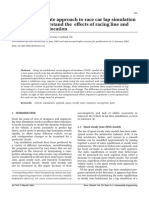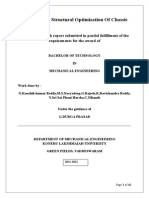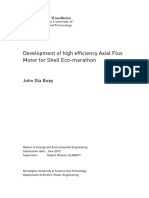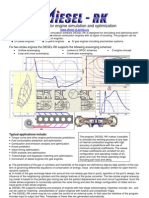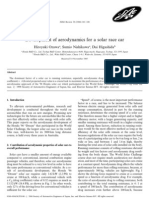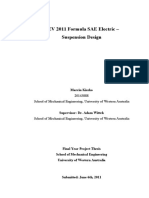FSAE Cooling System Design and Development
FSAE Cooling System Design and Development
Uploaded by
Gregory Aguilera LopesCopyright:
Available Formats
FSAE Cooling System Design and Development
FSAE Cooling System Design and Development
Uploaded by
Gregory Aguilera LopesCopyright
Available Formats
Share this document
Did you find this document useful?
Is this content inappropriate?
Copyright:
Available Formats
FSAE Cooling System Design and Development
FSAE Cooling System Design and Development
Uploaded by
Gregory Aguilera LopesCopyright:
Available Formats
FSAE Cooling System Design and Development Purpose and Motivation The FSAE racer goes through many
different stress and performance tests at less-thanideal conditions throughout the competition so it is crucial that its motor functions at the peak of its ability throughout the competition. As an ICE (internal combustion engine) the engine of the FSAE car rejects a large amount of heat as a result of the chemical explosions that continuously occur within it. If the engine is not cooled properly, it may overheat. The consequences of which could be mild or catastrophic to the life of the engine. Thus, the design and development of a proper cooling system is vital to the performance and life of the FSAE racer. This cooling system should not only keep the engine from overheating but also keep it at an optimum performance temperature determined through calculation. Design and Calculation Before design of the cooling system can begin, certain design requirements needed to be determined. These requirements included the average heat rejection of the engine, engine efficiency, tube size, coolant flow rate, radiator size and average vehicle speed. The amount of heat that was rejected by engine was calculated by assuming that engines power output was 1.5 and efficiency is about 20%. Now, based on the engines fuel consumption the power lost to heat was calculated by using the following equation ( ) ( ) ( ) (1)
where SG is the specific gravity of the fuel, CV is the caloric value of the fuel and V is the volume of the fuel. Solving this equation with the known values of V = 5.7 L, CV = 48 MJ/kg, and SG = 0.75 yields a power value of 97,714 Watts. However, since we assume that the engine is a typical ICE, its efficiency is assumed to be 0.2 therefore the actual power lost to heat is 19.5 kW. Now, in order to determine the cooling rate of the air around the radiator the mass flow rate of the air through the radiator and temperature difference of the air at the inlet and outlet of the radiator were determined. In order to determine the mass flow rate rate through a projected 12x12 radiator by using the following equation (2) the volume flow
where FA is the flow area and u is the velocity of the air flow plus the velocity of the air. Solving this equation for known values yields a volume flow rate of 1320 be rewritten as 0.62 . To determine the mass flow rate, . In SI units this value can
the volume flow rate was
multiplied by the density of air at 20C, 1.2 , and the final value was 0.748 . This value was then multiplied by the constant-pressure specific heat and the temperature difference between the inlet and the outlet of the radiator in order to solve for the rate of heat transfer between the projected radiator and the surrounding air which can be defined by the following equation (3) where is the difference in temperature between the inlet and outlet tube of the radiator which had a value of 83 K and was 1.01 . These temperatures were measured at a point where the engine had an rpm that corresponded to a vehicle speed of 15 mph. Solving Eq. 3 for the given values yielded a cooling rate of 60 kW. Since this value is much greater than amount of heat rejected by the engine, a 12x12 radiator should be sufficient to cool the engine during competition. Now, for cooling the engine while the car is stationary, the cooling fan must be able to move the air around the radiator at a sufficient rate. The first step in calculating this rate was manipulating Eq. 3 so that it could be used to solve for the necessary mass flow rate of air through the radiator to cool the engine. The new equation is (4)
where
in this case is the amount heat rejected by the engine or 19.5 kW. Dividing this mass
flow rate by the density of air yielded the required volume flow rate for the cooling fan: 723.6 . In order to determine the true size of the radiator that would be used, the effectivenessNTU method for heat exchangers was utilized. NTU is a dimensionless grouping called the number of transfer units and can be expressed as (5) where U is the overall heat transfer coefficient, is the heat transfer surface area of the heat exchanger, and is the smaller of Ch and Cc. Ch and Cc are the heat capacity rates of the hot
and cold fluids involved in a heat exchanger where, in this case, the hot fluid is the water leaving the engine and the cold fluid is the air traveling through the radiator. C is defined as (6) The ultimate goal of this method is to solve for the surface area of the heat exchanger. This will allow for the selection of the size of radiator. NTU can also be determined from graphs that relate NTU with the heat transfer effectiveness and with known values of Cmin and Cmax. The heat transfer effectiveness is defined as (7) where (8)
The mass flow rate for the water traveling through cooling system is 2.39 GPM and then converted to SI units for a value of 0.1449 . This mass flow rate for the water, the volume flow rate for the air and the tabulated specific heats for water and air are sufficient to solve Eq. 6 to obtain values for Cmax and Cmin. (9)
(10)
Therefore,
Using this result along with Eq. 8 yields
Eq. (3) was used with properties of air and a
of 27K and the result was (11)
Finally, the heat transfer effectiveness was calculated using Eq. 7 and the result was (12)
Now, using this value and the ratio (13) a value for NTU could be determined by looking up a value from the following graph
Figure 1: Heat transfer effectiveness as a function of NTU (C*= Cmin/Cmax) From the graph, (14) Using this value, an overall heat transfer coefficient of 60(
)
, and Eq.5 the heat transfer
surface area of the radiator could be solved for and the result of which was (15) Now, assuming 1 diameter tubes with 0.05 walls, the total length of the tubes within the radiator can be calculated so that the size of the radiator can be finalized.
( ) (16) So, the required total lengths of tubes is L = 200 in. If the base of the radiator is kept to 12 then in order to satisfy the total length the height must be 18. And thus, the final size of the radiator is 12x18. References [1] A. Ghajar, Y.A. Cengel. Heat and Mass Transfer. 4th ed. New York: McGraw-Hill, 1961. [2] Yang, Zhen, Zhenxing Zhao, Yinhe Liu, Yongqiang Chang, and Zidong Cao. "Convective Heat Transfer Characteristics of High-pressure Gas in Heat Exchanger with Membrane Helical Coils and Membrane Serpentine Tubes." Experimental Thermal and Fluid Science 35.7 (2011): 1427434.
You might also like
- 10.4324 9780080509037 PreviewpdfDocument22 pages10.4324 9780080509037 Previewpdfnina.debeljak11No ratings yet
- Do and Don't in Formula Student Design and ManufacturingDocument37 pagesDo and Don't in Formula Student Design and ManufacturingGregory Aguilera Lopes100% (2)
- A Quasi Steady State Approach To Race Car Lap Simulation in Order To Understand The Effects of Racing Line and Centre of Gravity LocationDocument15 pagesA Quasi Steady State Approach To Race Car Lap Simulation in Order To Understand The Effects of Racing Line and Centre of Gravity LocationIulian NgiNo ratings yet
- Siemens PLM Simcenter STAR CCM CFD Focused Multiphysics Simulation E BookDocument24 pagesSiemens PLM Simcenter STAR CCM CFD Focused Multiphysics Simulation E Book1797775186No ratings yet
- Aerodynamic Analysis and Optimisation of The Rear Wing of A WRC CarDocument81 pagesAerodynamic Analysis and Optimisation of The Rear Wing of A WRC CarVyssionNo ratings yet
- Formula SAE - Design Overview and Project ManagementDocument162 pagesFormula SAE - Design Overview and Project ManagementGregory Aguilera Lopes100% (1)
- LAW507 - June 2022 - TEST QUESTIONDocument9 pagesLAW507 - June 2022 - TEST QUESTIONIzatul ShimaNo ratings yet
- Analysis of Change in Intake Manifold Length and Development of Variable Intake SystemDocument6 pagesAnalysis of Change in Intake Manifold Length and Development of Variable Intake SystemDarius TothNo ratings yet
- FSAE Design Report 2ndversionDocument24 pagesFSAE Design Report 2ndversionananNo ratings yet
- Safety and Operating Manual: Scarifier 1300W Ttb428GdoDocument15 pagesSafety and Operating Manual: Scarifier 1300W Ttb428GdoArmoured SmilerNo ratings yet
- The Design Process of An Aerodynamic Package For An FSae CarDocument9 pagesThe Design Process of An Aerodynamic Package For An FSae CarJuantxoGarciaNo ratings yet
- Study of Inverted Multi Element Airfoils For FSAE/ Formula Student VehicleDocument1 pageStudy of Inverted Multi Element Airfoils For FSAE/ Formula Student VehicleFozanNo ratings yet
- FSAEDocument81 pagesFSAE69x4No ratings yet
- Advances in The Design of Two-Stroke, High Speed, Compression Ignition EnginesDocument34 pagesAdvances in The Design of Two-Stroke, High Speed, Compression Ignition EnginesenjpetNo ratings yet
- Data Acquisition System For A Formula SAE Race CarDocument43 pagesData Acquisition System For A Formula SAE Race CarRodrigo Bob100% (1)
- Vehicul HybridDocument89 pagesVehicul Hybridmihai_1957No ratings yet
- Cooling DesignDocument46 pagesCooling DesignDaisy Johnson0% (1)
- Racing Simulation of A Formula 1 Vehicle With Kinetic Energy Recovery SystemDocument15 pagesRacing Simulation of A Formula 1 Vehicle With Kinetic Energy Recovery SystemRodrigo Bob100% (1)
- Test of Link Force SuspensionDocument29 pagesTest of Link Force SuspensionJason RichardsonNo ratings yet
- Design and Analysis of Four Wheel Drive Electric VehicleDocument7 pagesDesign and Analysis of Four Wheel Drive Electric VehicleIJRASETPublicationsNo ratings yet
- Shell Eco Marathon Concept DesignDocument12 pagesShell Eco Marathon Concept DesignJeremy TetoncheNo ratings yet
- Boxer Engine: Group 4 MembersDocument3 pagesBoxer Engine: Group 4 MembersHamed Quenta AlvarezNo ratings yet
- Calculations For Springs and DampersDocument3 pagesCalculations For Springs and DampersDheeraj SirimallaNo ratings yet
- Chalmers Fsae - Presentación Global PDFDocument82 pagesChalmers Fsae - Presentación Global PDFJavier G. Almaner de la Torre100% (1)
- Designing Efficient Commuter Vehicle Using Finite Element Analysis and Computational Fluid DynamicsDocument6 pagesDesigning Efficient Commuter Vehicle Using Finite Element Analysis and Computational Fluid DynamicsSyed Anas SohailNo ratings yet
- Formula Student Adams ModelDocument124 pagesFormula Student Adams ModelOliver Grimes50% (2)
- Design of IC EngineDocument30 pagesDesign of IC EngineAshitosh SinghNo ratings yet
- Lap Sim EngineDocument5 pagesLap Sim Engineblack_oneNo ratings yet
- The Re-Design and Analysis of The Suspension System On The Formula Student Race CarDocument53 pagesThe Re-Design and Analysis of The Suspension System On The Formula Student Race CarPabloNo ratings yet
- V8 Supercar Case StudyDocument5 pagesV8 Supercar Case Studytushar girotraNo ratings yet
- Grand Prix Motorradmotoren Design Alternatives For MotoGP Engines Gordon P. BlairDocument14 pagesGrand Prix Motorradmotoren Design Alternatives For MotoGP Engines Gordon P. BlairLuizGustavoVicenteNo ratings yet
- Formula Sae Final ReportDocument95 pagesFormula Sae Final ReportShailendra SinghNo ratings yet
- Chassis OptimizationDocument42 pagesChassis OptimizationNavyadeep SaiNo ratings yet
- Eco Marathon Axial FluxDocument35 pagesEco Marathon Axial Fluxphysics802No ratings yet
- Fsae Exhaust ReportDocument8 pagesFsae Exhaust ReportGodwin JerryNo ratings yet
- Quick Shift System For FSAE CarsDocument23 pagesQuick Shift System For FSAE CarsShamanthManjunathNo ratings yet
- What Is A Diesel-RKDocument4 pagesWhat Is A Diesel-RKSarawoot WatechagitNo ratings yet
- Development of Aerodynamics For A Solar Race CarDocument7 pagesDevelopment of Aerodynamics For A Solar Race CarAmr MagdyNo ratings yet
- Solving The Powertrain PuzzleDocument517 pagesSolving The Powertrain PuzzleIgor MândruNo ratings yet
- Masters Thesis MonashDocument97 pagesMasters Thesis Monashmohit sonawaneNo ratings yet
- 7 Claude Roulle PDFDocument39 pages7 Claude Roulle PDFPrateek KesarwaniNo ratings yet
- A Study of Kinetic Energy Recovery SystemsDocument57 pagesA Study of Kinetic Energy Recovery SystemsMohammad Usman0% (1)
- Getting More From Your Yaw DiagramsDocument3 pagesGetting More From Your Yaw DiagramstrisinoNo ratings yet
- A Robust CFD Methodology For Physically Realistic and Economically Feasible Results in Racing - Part II Intake CowlDocument27 pagesA Robust CFD Methodology For Physically Realistic and Economically Feasible Results in Racing - Part II Intake CowlAllan Bruno RosaNo ratings yet
- Formula SAE Engine DesignDocument188 pagesFormula SAE Engine DesignVincent GiangNo ratings yet
- Mechanical KERS For Automotive ApplicationsDocument4 pagesMechanical KERS For Automotive ApplicationsVelshankar MJNo ratings yet
- Design and Analysis of Six Stroke Internal Combustion EngineDocument4 pagesDesign and Analysis of Six Stroke Internal Combustion Engineabhijith thankachanNo ratings yet
- 4WS On Formula Student Racing CarDocument12 pages4WS On Formula Student Racing CarVictorNo ratings yet
- Comparative Analysis of Vehicle Suspension System in Matlab-Simulink and Msc-Adams With The Help of Quarter Car ModelDocument8 pagesComparative Analysis of Vehicle Suspension System in Matlab-Simulink and Msc-Adams With The Help of Quarter Car ModelHemanth KrishnaNo ratings yet
- Optimal Valve TimingDocument19 pagesOptimal Valve TimingjehadyamNo ratings yet
- Renault Reveals 2014 Formula 1 Power Unit v6 55588Document17 pagesRenault Reveals 2014 Formula 1 Power Unit v6 55588Blaze123xNo ratings yet
- Valved Two Stroke EngineDocument10 pagesValved Two Stroke EngineBlaž VerdevNo ratings yet
- 2011 REV SAE Suspension Kiszco PDFDocument112 pages2011 REV SAE Suspension Kiszco PDFRushik KudaleNo ratings yet
- Development of A Bellmouth Airflow Measurement Technique For Turbine Engine Ground Test FacilitiesDocument21 pagesDevelopment of A Bellmouth Airflow Measurement Technique For Turbine Engine Ground Test FacilitiesNicolas DuboisNo ratings yet
- Aerodynamics of Road Vehicles: Wolf-Heinrich HuchoDocument53 pagesAerodynamics of Road Vehicles: Wolf-Heinrich HuchoFozan100% (1)
- Race Car Designing ProcedureDocument5 pagesRace Car Designing ProcedureBalaji AeroNo ratings yet
- Design and Optimization of Impact Attenuator For A Formula SAE Racing Car (Document12 pagesDesign and Optimization of Impact Attenuator For A Formula SAE Racing Car (Praveen BandaraNo ratings yet
- FSAE Aero Initial Performance Predictions - MonashDocument10 pagesFSAE Aero Initial Performance Predictions - MonashPedro BarataNo ratings yet
- Effect of Intercooler On Turbocharged EngineDocument4 pagesEffect of Intercooler On Turbocharged EngineShivam Sharma100% (1)
- Development of Chilled Water Turbine Inlet Air Cooling Model For Enhancement of Turbine PerformanceDocument8 pagesDevelopment of Chilled Water Turbine Inlet Air Cooling Model For Enhancement of Turbine PerformanceAklilu BahetaNo ratings yet
- Modeling An Air-Cooled Gas Turbine of The Integrated Gasification Combined Cycle in Aspen PlusDocument6 pagesModeling An Air-Cooled Gas Turbine of The Integrated Gasification Combined Cycle in Aspen Plusdafer_daniNo ratings yet
- Optimization of Diameter Ratio For Alpha-Type Stirling EnginesDocument6 pagesOptimization of Diameter Ratio For Alpha-Type Stirling EnginesEmiliano VelázquezNo ratings yet
- RamjetsDocument7 pagesRamjetsmaniNo ratings yet
- Mechanical Behaviors of Carbon Fiber Reinforced CompositeDocument6 pagesMechanical Behaviors of Carbon Fiber Reinforced CompositeGregory Aguilera LopesNo ratings yet
- Production of A Composite Monocoque Frame For A Formula SAE RacecarDocument10 pagesProduction of A Composite Monocoque Frame For A Formula SAE RacecarGregory Aguilera LopesNo ratings yet
- Design of A CFRP Composite Monocoque Simulation ApproachDocument8 pagesDesign of A CFRP Composite Monocoque Simulation ApproachGregory Aguilera LopesNo ratings yet
- Iso 532Document20 pagesIso 532Gregory Aguilera LopesNo ratings yet
- SAE J328 Test Requirements 1990Document2 pagesSAE J328 Test Requirements 1990AnirudhNo ratings yet
- 2019 02 01 Racecar EngineeringDocument100 pages2019 02 01 Racecar EngineeringGregory Aguilera LopesNo ratings yet
- O-Ring Gland DesignsDocument28 pagesO-Ring Gland DesignsGregory Aguilera LopesNo ratings yet
- Sucess Story CD Adapco STAR CCM Formula FEI Racing Team 2013Document7 pagesSucess Story CD Adapco STAR CCM Formula FEI Racing Team 2013Gregory Aguilera LopesNo ratings yet
- Eng Flyer Service Scope PDFDocument4 pagesEng Flyer Service Scope PDFIon CîmpeanuNo ratings yet
- Computer Vision: Homework 5 3D ReconstructionDocument6 pagesComputer Vision: Homework 5 3D ReconstructionNorah M KiggunduNo ratings yet
- Assignment MKT 234 Fundamentals of MarketingDocument16 pagesAssignment MKT 234 Fundamentals of MarketingWan Khairul HamizanNo ratings yet
- Construction and Working of Brushless DC PDFDocument12 pagesConstruction and Working of Brushless DC PDFaswardi8756No ratings yet
- SIL Determination-Mode of Operation PDFDocument6 pagesSIL Determination-Mode of Operation PDFchem_taNo ratings yet
- Firelock Rigid Coupling Style 005H With Vic-Plus Gasket SystemDocument3 pagesFirelock Rigid Coupling Style 005H With Vic-Plus Gasket SystemIhsan OzzyNo ratings yet
- Serial Converter InterfaceDocument4 pagesSerial Converter InterfaceCarlos Enrique Pacheco HerreraNo ratings yet
- Chatgpt Prtical GuideDocument38 pagesChatgpt Prtical GuideVarsha KapurNo ratings yet
- Datasheet sk107Document2 pagesDatasheet sk107andrelupus1No ratings yet
- Sharp Tool PolicyDocument7 pagesSharp Tool PolicyVijay Baskar SNo ratings yet
- Specification Sheet Solar Module - KM (P) 30Document1 pageSpecification Sheet Solar Module - KM (P) 30madsonengNo ratings yet
- INTE Worksheet 8Document4 pagesINTE Worksheet 8taqy tuzkaNo ratings yet
- Binder 20Document12 pagesBinder 20Fawadsubhan JalilNo ratings yet
- CV Hitesh FOR DMDocument3 pagesCV Hitesh FOR DMhiteshNo ratings yet
- Atelyn AnvrinDocument1 pageAtelyn Anvrinapi-509623933No ratings yet
- Marijuana Equivalency in Portion and DosageDocument44 pagesMarijuana Equivalency in Portion and DosagesaludemosNo ratings yet
- Application Security - Unit 3 PDFDocument146 pagesApplication Security - Unit 3 PDFViswantahNo ratings yet
- Solar Wheel ChairDocument4 pagesSolar Wheel ChairJournalNX - a Multidisciplinary Peer Reviewed JournalNo ratings yet
- SAS 6 - Abapo, Aquea B.Document5 pagesSAS 6 - Abapo, Aquea B.Aquea Bernardo AbapoNo ratings yet
- Annexure-2 (Dealer Consent Letter)Document2 pagesAnnexure-2 (Dealer Consent Letter)KaushikNo ratings yet
- 10Mhz To 1050Mhz Integrated RF Oscillator With Buffered OutputsDocument11 pages10Mhz To 1050Mhz Integrated RF Oscillator With Buffered OutputsmadhukirNo ratings yet
- Custom Accessories v. Premier Accessory Group - ComplaintDocument30 pagesCustom Accessories v. Premier Accessory Group - ComplaintSarah BursteinNo ratings yet
- Functionality TestingDocument7 pagesFunctionality TestingKancharlaNo ratings yet
- Negotiation Power PointDocument14 pagesNegotiation Power PointVikas JhabakNo ratings yet
- AAEC PASCAL 9000 Reference Version 1.2 Jan 2 1978Document64 pagesAAEC PASCAL 9000 Reference Version 1.2 Jan 2 1978Marco Polo100% (1)
- Ankit Patel ResumeDocument1 pageAnkit Patel ResumeAnkitkumar PatelNo ratings yet
- JNTUA IoT TextDocDocument11 pagesJNTUA IoT TextDocAmbarkar SupriyaNo ratings yet


